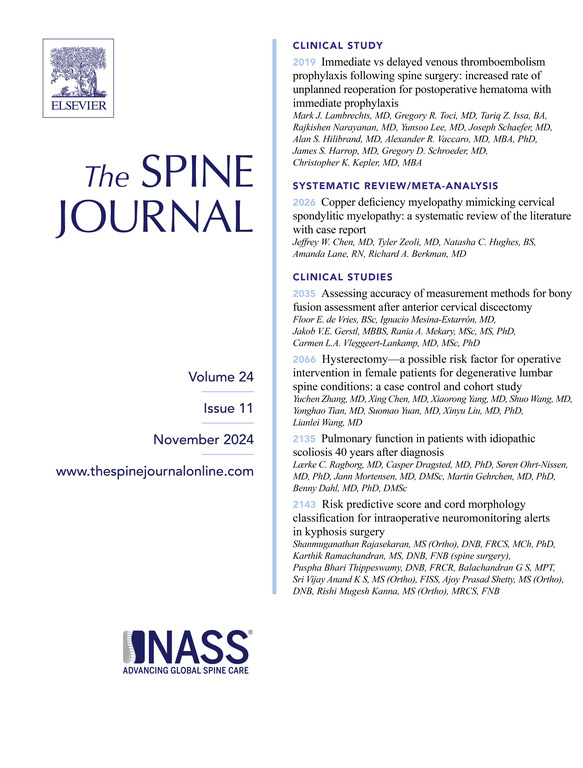肥胖是颈椎前路椎间盘切除和融合术后肺栓塞的独立风险因素。
IF 4.9
1区 医学
Q1 CLINICAL NEUROLOGY
引用次数: 0
摘要
背景:在过去十年中,美国肥胖症的发病率与颈椎椎间盘切除前路融合术(ACDF)的需求同步上升。之前的研究评估了较小患者群体中肥胖等级在颈椎手术中的作用。目的:本研究旨在分析肥胖程度对接受 ACDF 患者围手术期并发症发生率的影响:回顾性队列、大型多中心数据库研究:患者样本:通过查询美国外科学院国家外科质量改进计划(ACS-NSQIP)数据库,确定在2011年至2020年间接受过选择性ACDF手术的患者,并使用当前程序术语(CPT)代码22551:结果测量:术后三十天内的医疗和手术并发症:将患者分为四个 BMI 组:非肥胖(BMI 18.5-29.9 kg/m2)、肥胖 I 级(BMI 30-34.9 kg/m2)、肥胖 II 级(BMI 35-39.9 kg/m2)和肥胖 III 级(BMI ≥40 kg/m2)。对人口统计学变量和术前合并症进行的单变量分析发现,年龄、性别、种族、吸烟状况、需要药物治疗的高血压、糖尿病、充血性心力衰竭病史、出血性疾病病史和慢性阻塞性肺病是风险因素。采用卡方检验比较各组并发症的发生率。随后进行了多变量逻辑回归分析,以调整这些术前风险因素,并比较 I-III 级肥胖与非肥胖患者:结果:共发现 64,718 名患者,其中 33,365 人为非肥胖患者,17,190 人为肥胖 I 级患者,8,608 人为肥胖 II 级患者,5,555 人为肥胖 III 级患者。肥胖 I-III 级患者的手术部位感染(0.33%、0.36%、0.41% 对 0.24%,P = 0.039)和肺栓塞(PE)(0.25%、0.31%、0.29 对 0.15%,P = 0.003)发生率较高。肥胖I-III级的输血发生率较低(0.23%、0.17%、0.27% vs 0.4%,P < 0.001),肥胖I级、肥胖II级和肥胖III级分别独立增加了PE的风险(OR:1.716,95% CI (1.129-2.599);OR:2.213,95% CI (1.349-2.3.559);OR:2.207,95% CI (1.190-3.892)):结论:与非肥胖患者相比,肥胖 I-III 级患者在 ACDF 术后发生 PE 的风险明显更高。这些发现可能进一步支持在围手术期采取额外的预防措施。本文章由计算机程序翻译,如有差异,请以英文原文为准。
Obesity is an independent risk factor for postoperative pulmonary embolism after anterior cervical discectomy and fusion
BACKGROUND
Over the past decade, the prevalence of obesity has risen in the United States, in parallel with the demand for anterior cervical discectomy with fusion (ACDF). Prior studies have evaluated the role of obesity classes in cervical spine surgery in smaller patient populations. We aimed to evaluate any potential correlation to a national population sample by utilizing a large multicenter database.
PURPOSE
The purpose of this study was to analyze obesity level's influence on perioperative complication rates in patients undergoing ACDF.
STUDY DESIGN/SETTING
A retrospective cohort, large multicenter database study.
PATIENT SAMPLE
The American College of Surgeons National Surgical Quality Improvement Program (ACS-NSQIP) database was queried to identify patients who had undergone an elective ACDF procedure between 2011 and 2020 using Current Procedural Terminology (CPT) code 22551.
OUTCOME MEASURES
Medical and surgical complications within thirty days of operation.
METHODS
Patients were categorized into four BMI groups: nonobese (BMI 18.5−29.9 kg/m2), obese class I (BMI 30−34.9 kg/m2), obese class II (BMI 35−39.9 kg/m2), and obese class III (BMI ≥40 kg/m2). A univariate analysis conducted for demographic variables and preoperative comorbidities identified age, sex, race, smoking status, hypertension requiring medication, diabetes, history of congestive heart failure, history of bleeding disorder, and chronic obstructive pulmonary disease as risk factors. Chi-square test was used to compare incidence of complications among groups. A multivariable logistic regression analysis was subsequently performed to adjust for these preoperative risk factors and compare obesity classes I-III to nonobese patients.
RESULTS
About 64,718 patients were identified of whom 33,365 were nonobese, 17,190 were obese class I, 8,608 were obese class II, and 5,555 were obese class III. Obese classes I-III patients had a higher incidence of surgical site infections (0. 33%, 0.36%, 0.41%, vs 0.24%, p=.039) and pulmonary embolism (PE) (0.25%, 0.31, 0.29 vs 0.15%, p=.003). Obese classes I-III had a lower incidence of blood transfusion (0.23%, 0.17%, 0.27% vs 0.4%, p<.001) obese class I, obese class II, and obese class III independently increased the risk for PE (OR: 1.716, 95% CI (1.129−2.599); OR: 2.213, 95% CI (1.349−3.559); OR: 2.207, 95% CI (1.190--3.892), respectively).
CONCLUSIONS
Risk for postoperative PEs after an ACDF was significantly higher for obese classes I-III compared to nonobese patients. These findings may further support the use of additional prophylaxis measures and precaution in the perioperative setting.
求助全文
通过发布文献求助,成功后即可免费获取论文全文。
去求助
来源期刊

Spine Journal
医学-临床神经学
CiteScore
8.20
自引率
6.70%
发文量
680
审稿时长
13.1 weeks
期刊介绍:
The Spine Journal, the official journal of the North American Spine Society, is an international and multidisciplinary journal that publishes original, peer-reviewed articles on research and treatment related to the spine and spine care, including basic science and clinical investigations. It is a condition of publication that manuscripts submitted to The Spine Journal have not been published, and will not be simultaneously submitted or published elsewhere. The Spine Journal also publishes major reviews of specific topics by acknowledged authorities, technical notes, teaching editorials, and other special features, Letters to the Editor-in-Chief are encouraged.
 求助内容:
求助内容: 应助结果提醒方式:
应助结果提醒方式:


